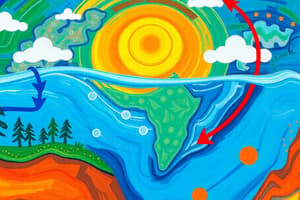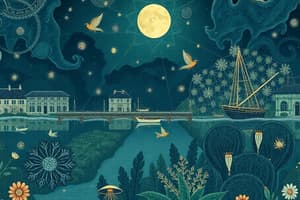Podcast
Questions and Answers
What percentage of the Earth's land was covered by glaciers during the last Ice Age?
What percentage of the Earth's land was covered by glaciers during the last Ice Age?
- 10%
- 40%
- 20% (correct)
- 30%
Glaciers contribute to rising ocean waters by melting quickly.
Glaciers contribute to rising ocean waters by melting quickly.
True (A)
What is the term for the area of land that drains into a body of water?
What is the term for the area of land that drains into a body of water?
Watershed
The most recent Ice Age began approximately _________ years ago.
The most recent Ice Age began approximately _________ years ago.
Match the following drainage basins with their physical features:
Match the following drainage basins with their physical features:
What percentage of the Earth's water is fresh water?
What percentage of the Earth's water is fresh water?
Ocean water has a higher freezing point than fresh water.
Ocean water has a higher freezing point than fresh water.
Name two sources of fresh water.
Name two sources of fresh water.
The process of water changing from a liquid to a gas is called __________.
The process of water changing from a liquid to a gas is called __________.
Match the terms listed with their definitions:
Match the terms listed with their definitions:
Which of the following factors affects runoff?
Which of the following factors affects runoff?
The Dead Sea is an example of fresh water.
The Dead Sea is an example of fresh water.
What causes ocean water to be more dense than fresh water?
What causes ocean water to be more dense than fresh water?
Flashcards
What is the Lithosphere?
What is the Lithosphere?
The solid, rocky outer layer of the Earth.
What is the Hydrosphere?
What is the Hydrosphere?
All the water on Earth, including water in the lithosphere and atmosphere.
What is the Atmosphere?
What is the Atmosphere?
The layer of gases surrounding the Earth.
What is the Water Cycle?
What is the Water Cycle?
Signup and view all the flashcards
What is Ocean Water?
What is Ocean Water?
Signup and view all the flashcards
What is Salinity?
What is Salinity?
Signup and view all the flashcards
What is Density?
What is Density?
Signup and view all the flashcards
What is Groundwater?
What is Groundwater?
Signup and view all the flashcards
Glacier's Role in Water Cycle
Glacier's Role in Water Cycle
Signup and view all the flashcards
Drainage Basin
Drainage Basin
Signup and view all the flashcards
Divide
Divide
Signup and view all the flashcards
Salinity and Organisms
Salinity and Organisms
Signup and view all the flashcards
Temperature and Dissolved Oxygen
Temperature and Dissolved Oxygen
Signup and view all the flashcards
Study Notes
Grade 8 Science: Unit 1 - Water Systems on Earth
- This unit explores Earth's water systems
- Topics covered include water's effects, distribution, the water cycle, differences between ocean and fresh water, sources of fresh water, and the impact of glaciers and global warming.
Effects of Water
- Images of the Churchill River and large ocean waves illustrate water's impact.
- Water use categorized by uses: Household, Personal, and Recreational (as buttons on a screen).
Water Distribution
- Only 3% of Earth's water is fresh water.
- Two-thirds of fresh water is frozen in ice sheets.
- Only 1% of the Earth's fresh water is readily available.
- Earth's water broken down: Saline (oceans) 97%, Fresh water 3%.
- Fresh water further broken down into: Ground water 30.1%, Ice caps & Glaciers 68.7%, Surface water 0.3%, Rivers 2%, Lakes 87%, Swamps 11% , Other 0.9%.
- This detailed breakdown of water distribution illustrates the relative abundance of different types of water on Earth.
The Water Cycle
- Water constantly cycles between liquid, gas (vapor), and solid (ice) forms.
- Evaporation from the ocean contributes about 80% of the water vapor in the atmosphere
- Precipitation, runoff, groundwater, and cloud formation are key aspects of the water cycle.
- The sun's energy drives the water cycle.
Ocean Water vs. Fresh Water
-
Salinity: The amount of salt dissolved in a specific amount of water.
- Ocean water salinity is about 35 parts per thousand (ppt), and varies by location.
- Fresh water has tiny amounts of salt
-
Density: The amount of mass of a substance in a volume.
- Ocean water is more dense than fresh water.
-
Freezing point: Water freezes at 0°C (fresh water) and -1.9°C (sea water)
Sources of Fresh Water
- Lakes, ponds, and wetlands
- Streams and rivers.
- Groundwater: Precipitation that sinks into the ground and collects in rock pores
- Wells can be drilled to reach groundwater.
- Glaciers: Moving masses of snow and ice (mostly from snowy areas), found in cold areas.
- Drainage basins: Areas of land that drain water into a particular body of water.
Glaciers
- Glaciers are moving masses of snow and ice.
- They are found in areas with persistent cold, snow accumulates year-round.
- Glaciers store a large amount of water for the water cycle (slowing it down), and are released during warmer periods.
- They provide information on past climates.
- The images show current glacier melt from past glacier photos.
The Ice Age
- The most recent ice age began 120,000 years ago and ended 11,000 years ago.
- Glaciers covered roughly 20% of Earth's land during the ice age.
Glaciers and Global Warming
- Average global temperatures have risen by 0.5°C over the last 100 years.
- Glaciers are now melting at a faster rate than in the past.
Drainage Basins
- Drainage basins are areas of land that drains water into a body of water such as a river, pond, lake, or ocean.
- Divides separate one drainage basin from another (e.g., The Continental Divide).
- Canada has multiple drainage basins
One Component Affects Another
-
Factors like salinity and temperature influence the types of organisms that can survive in a particular area.
- Salinity affects ocean life whereas temperature affects oxygen dissolved in water
-
Convergence of currents (e.g., Labrador and Gulf Stream) affects productivity, icebergs formation, and animal migration.
Studying That Suits You
Use AI to generate personalized quizzes and flashcards to suit your learning preferences.




